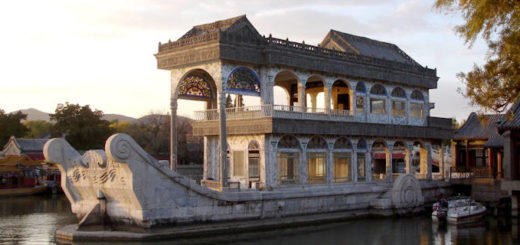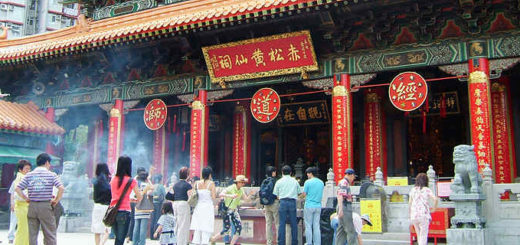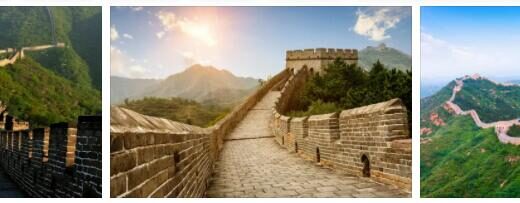Temple of Heaven in Beijing (World Heritage)
The temple complex in the southeast of Beijing was of great spiritual importance in imperial China. The architecture of the buildings symbolizes the relationship between heaven and earth and the position of the emperor. The most important building in the temple complex is the »Hall of the Harvest Victims«. The 38 m high rotunda is made entirely of wood and the roof is covered with blue glazed tiles. The second important building is the smaller “Hall of Heaven”, also circular and surrounded by the “Echo Wall”.
Temple of Heaven in Beijing: facts
| Official title: | Temple of Heaven with an imperial sacrificial altar in Beijing |
| Cultural monument: | located within a 0.273 km² park; Temple complex with the “Hall of the Harvest Victims”, the “Gate of the Harvest Victims”, the “Hall of the Vault of Heaven” (or heavenly tent), the 350 m long terrace called “Bridge of the Red Palace Steps”, the “Hall of Fasting” and the Heavenly Altar (Huan Qiu Tan), whose architecture is determined by the number 9, so in the number of stone slabs for the platform, steps and balustrades |
| Continent: | Asia |
| Country: | China |
| Location: | Southeast of Peking (Beijing) |
| Appointment: | 1998 |
| Meaning: | Symbol for the relationship between heaven and earth and the importance of the emperor within this relationship |
Temple of Heaven in Beijing: History
| 1406 | start of building |
| 1420 | Completion of the »Hall of the Harvest Victims« |
| 1530 | Construction of the sky altar, also known as the »round mountain«, and the »hall of the heavenly vault« |
| 1749 | Renewal of the sky altar |
| 1889 | After being destroyed by a lightning strike, the 38 m high, wooden »Hall of the Victims of the Harvest« was rebuilt |
A miracle in blue
When the sun shines, the deep blue porcelain tiles of the rotunda, which with its three-story roof is the main attraction of the complex, shine against the blue of the firmament. But even with a cloudy sky, the colors do not lose any of their splendor and power. In winter parents and their thickly hooded children romp around on the grounds, in summer old women sit on benches under shady trees and let their legs and soul dangle.
The Tian Tan, symbolizing the union of heaven and earth and the largest park and temple complex in Beijing, belongs to the citizens of the city more than the Imperial Palace, through which thousands of tourists are smuggled every day. Its filigree, harmonious architecture and mysterious pine and cypress groves make it an ideal refuge in the Chinese metropolis, which is built with sterile concrete castles and tormented by traffic jams. Ordinary mortals have only been allowed to enter this park since 1912. The temple precinct was sacred; this is where the emperors of the Ming and Qing dynasties came to communicate with heaven and to pray for a good harvest. Every year three days before the winter solstice, the emperor left his palace and set out for the temple precinct. The procession was splendid the regent was sitting in a litter, and the city was dead quiet. Citizens had been asked to stay in their homes, and all foreigners living in the city had been forbidden by decree from even looking at the imperial pageant. Construction of the temple complex began in the first decade of the 15th century, and after 14 years of construction the attractive main building stood, then called the »Hall of Solemn Adoration«, later called »Hall of the Harvest Sacrifice«. With its blue glazed roofs, the majestic monument is something of a landmark in Beijing today. In the 16th century, the emperors had the “Hall of the Vault of Heaven”, primarily used to store ceremonial tables, and the heavenly altar built on which food offerings were offered. These sacred sites and the trees, some of which are five centuries old, are surrounded by a double wall. The layout of the complex has a symbolic meaning: the enclosure, which is rectangular in the south, represents the earth, which is square according to the classical Chinese understanding, while the rounded part in the north represents the sky.
Qi Nian Dian, the »Hall of Harvest Victims«, is remarkable in many ways: apart from its 50,000 shiny glazed tiles on the roof, the 38 m high rotunda is made entirely of wood, but not a single nail was hammered into its construction. The roof rests on a total of 28 pillars. In the center are four huge, almost 20 m high support beams, which are decorated with golden dragons and represent the four seasons. The quartet is surrounded by twelve central columns that symbolize the twelve months of a year. The twelve outer pillars stand for the twelve times of the day, because in the traditional Chinese calendar, a double hour was counted as a unit.
The floor of the hall, which was destroyed by lightning in 1889 and then rebuilt in its current dimensions, is adorned with a marble slab. According to franciscogardening, a stone with symbolic power, because its grain is reminiscent of two important Chinese mythical animals: the dragon, emblem of the emperor, and the phoenix, symbol of the empress. The fact that these mythological beings also embody heaven and earth gives the portrait a double meaning.
In addition to architectural wonders, the “heavenly park” also offers acoustic wonders – for example, the famous echo wall, on which even a whisper propagates to the most distant corners, or the three “echo stones”, which are a very special one in front of the “hall of the heavenly vault” Provide an effect: if you clap your hands while standing on the first stone, an echo comes back; standing on the second stone there are two, on the third three echoes.



